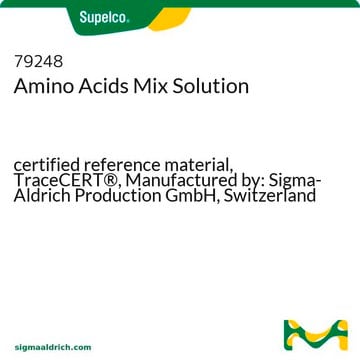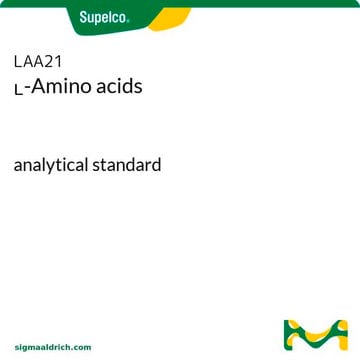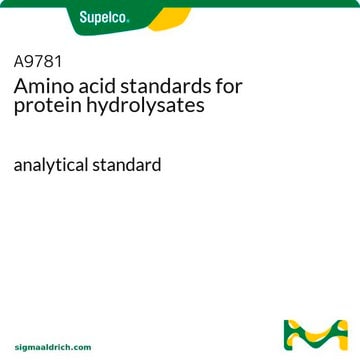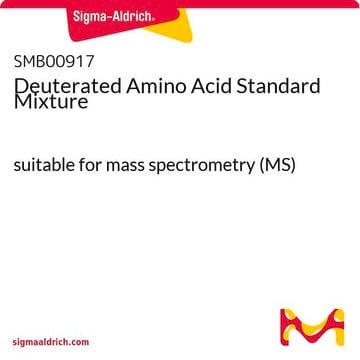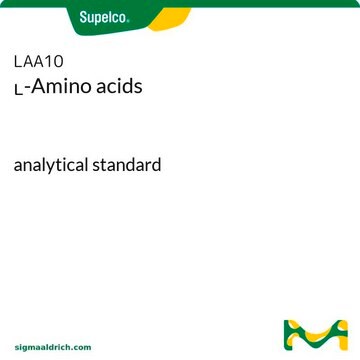This standard can be derivatized using MSFTA and subsequently used for GCMS analysis.
Wichtige Dokumente
AAS18
Aminosäure-Standard
analytical standard
Größe auswählen
Größe auswählen
About This Item
Empfohlene Produkte
Qualität
analytical standard
Haltbarkeit
limited shelf life, expiry date on the label
chemische Klasse(n) des Analyten
amino acids, peptides, proteins
Methode(n)
HPLC: suitable
gas chromatography (GC): suitable
Anwendung(en)
food and beverages
Format
multi-component solution
Lagertemp.
2-8°C
Verwandte Kategorien
Anwendung
- Bestimmung von L- und D-Aminosäuren sowie Glycin mittels Flüssigchromatografie-Tandem-Massenspektrometrie (LC-MS/MS), gefolgt von ihrer Derivatisierung mit chiralem Marfey-Reagenz
- Hochleistungsflüssigkeitschromatografie(HPLC)-basierte Aminosäurenanalyse während der Charakterisierung von entfettete Reiskleie(DRB)-Proteinkonzentrat zum Untersuchen seiner Eisenbindungsfähigkeit
- Entwicklung eines Gaschromatografie-Massenspektrometrie(GC-MS)-Verfahrens für die Profilerstellung von 112 Aminocarbonsäuremetaboliten in humanen Urinproben unter Verwendung von 1,1,1,2,2,3,3-Heptafluorbutylchlorformiat zur Derivatisierung und Flüssig-Flüssig-Mikroextraktion für die Probenbehandlung
- Nichtenantiomerischer Nachweis und Quantifizierung von Aminosäuren in ihren verschiedenen Formen— (frei, gelöst, teilchenförmig und gesamt) in natürlichen Wasserproben mittels an einen Fluoreszenznachweis gekoppelte HPLC unter Verwendung einer C18-Säule
Verpackung
Komponenten
- L-Alanin
- Ammoniumchlorid
- L-Arginin
- L-Asparaginsäure
- L-Cystin
- L-Glutaminsäure
- Glycin
- L-Histidin
- L-Isoleucin
- L-Leucin
- L-Lysin
- L-Methionin
- L-Phenylalanin
- L-Prolin
- L-Serin
- L-Threonin
- L-Tyrosin
- L-Valin
Sonstige Hinweise
Ähnliches Produkt
Signalwort
Warning
H-Sätze
P-Sätze
Gefahreneinstufungen
Met. Corr. 1
Lagerklassenschlüssel
8B - Non-combustible corrosive hazardous materials
WGK
nwg
Flammpunkt (°F)
Not applicable
Flammpunkt (°C)
Not applicable
Hier finden Sie alle aktuellen Versionen:
Analysenzertifikate (COA)
Die passende Version wird nicht angezeigt?
Wenn Sie eine bestimmte Version benötigen, können Sie anhand der Lot- oder Chargennummer nach einem spezifischen Zertifikat suchen.
Besitzen Sie dieses Produkt bereits?
In der Dokumentenbibliothek finden Sie die Dokumentation zu den Produkten, die Sie kürzlich erworben haben.
-
Can this Amino acid standard be used for GCMS analysis? And can it be subjected to MSFTA derivitisation?
1 answer-
Helpful?
-
-
What is the suggested procedure to hydrolyse cystine? Does the hydrolysis procedure affect other amino acids?
1 answer-
This product is intended to be used as an analytical standard and is not suitable for chemical processing. Please contact your regional technical service group for assistance with suitable reagents for your application.
Helpful?
-
-
Is there a recommended HPLC method and associated chromatogram to allow identification of each of the peaks and quantification of each amino acid in a sample (by retention time/integration)?
1 answer-
No method is available to identify each of the peaks for this product. Contact the regional Technical Service group for assistance with identifying chromatographic peaks according to specific analytical techniques.
Helpful?
-
-
How is shipping temperature determined? And how is it related to the product storage temperature?
1 answer-
Products may be shipped at a different temperature than the recommended long-term storage temperature. If the product quality is sensitive to short-term exposure to conditions other than the recommended long-term storage, it will be shipped on wet or dry-ice. If the product quality is NOT affected by short-term exposure to conditions other than the recommended long-term storage, it will be shipped at ambient temperature. As shipping routes are configured for minimum transit times, shipping at ambient temperature helps control shipping costs for our customers. For more information, please refer to the Storage and Transport Conditions document: https://www.sigmaaldrich.com/deepweb/assets/sigmaaldrich/marketing/global/documents/316/622/storage-transport-conditions-mk.pdf
Helpful?
-
-
How can I determine the shelf life / expiration / retest date of this product?
1 answer-
If this product has an expiration or retest date, it will be shown on the Certificate of Analysis (COA, CofA). If there is no retest or expiration date listed on the product's COA, we do not have suitable stability data to determine a shelf life. For these products, the only date on the COA will be the release date; a retest, expiration, or use-by-date will not be displayed.
For all products, we recommend handling per defined conditions as printed in our product literature and website product descriptions. We recommend that products should be routinely inspected by customers to ensure they perform as expected.
For products without retest or expiration dates, our standard warranty of 1 year from the date of shipment is applicable.
For more information, please refer to the Product Dating Information document: https://www.sigmaaldrich.com/deepweb/assets/sigmaaldrich/marketing/global/documents/449/386/product-dating-information-mk.pdfHelpful?
-
-
What is the difference between AAS18 and 79248 (CRM)? What are the storage and shipping conditions? How does the quality of AAS18 compare to CRM?
1 answer-
AAS18 is stored at 2-8°C, while 79248 is stored at -20°C. Both are shipped at ambient temperature. Amino Acid 79248 is a CRM, Certified Reference Material, and AAS18 is a standard. AAS18 does not undergo the rigorous testing that is used for CRM standards.
Helpful?
-
-
Wie lange ist der AAS18 Aminosäuren Standard haltbar, wenn er bei Temperaturen von 2-8°C gelagert wird?
1 answer-
The expiration date of this product is listed on the lot-specific Certificate of Analysis.
Please access the link below to download a Certificate:
https://www.sigmaaldrich.com/product/sial/aas18#product-documentationHelpful?
-
Active Filters
Unser Team von Wissenschaftlern verfügt über Erfahrung in allen Forschungsbereichen einschließlich Life Science, Materialwissenschaften, chemischer Synthese, Chromatographie, Analytik und vielen mehr..
Setzen Sie sich mit dem technischen Dienst in Verbindung.